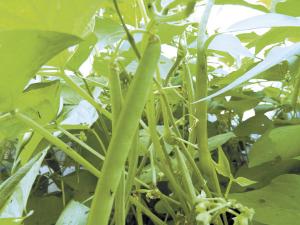Replant your garden in July with fast-growing crops
In the musical “Oklahoma,” the corn was “as high as an elephant’s eye,” which made for some very tall corn, or very short elephants. Traditionally, corn was said to be “knee high by the Fourth of July,” assuring that the corn was well on its way to reaching the usual eight feet tall it needs to produce a crop. But even if you don’t have corn, you can use July to plant quick-growing flowers and vegetables in time to finish before frost.
After you pick early-maturing vegetables such as bush beans, lettuce, radishes, peas and spinach, you still have time to plant more crops for a late summer or fall harvest. Before planting, dig in some compost and cultivate the soil just as you would in early spring.
Bush snap beans mature in just 40 to 55 days. Try planting a different variety of bush beans every week or two so you have a nice staggered harvest.
Carrots planted now will have time to grow before frost. With carrots, the smaller the better, and you will find that if you thin the carrot patch after four weeks you can eat the thinnings as gourmet baby carrots. Round carrots such as Parisian or Planet can even be grown in pots.
Cucumbers grow lightning quick, with many going from seed to harvest in just 50 days. You can even plant bush cucumbers in large pots. For containers, try Bush Crop or Spacemaster cucumbers.
Plant hardy kale right into August for a continuous supply of leaves. Dwarf Blue kale matures in under two months.
Beets not only mature in under two months, but you can pick the leaves all summer long for nutritious greens. Mustard greens will just about jump out of the garden, going from seed to harvest in under 40 days.
While lettuce tends to go to seed or “bolt” during the hot days of summer, you can try nursing some along in a shady spot with plenty of water.
Herbs grown for their leaves are also a good bet for July planting. Try seeding sweet basil, cilantro and dill.
In the flower garden, put in more transplants of annuals such as marigolds, zinnias and petunias. Direct seed cosmos, calendula and sunflowers for blooms later in the season when many earlier flowers are burned out by the heat.
You can use summer planting time to fertilize your soil by planting cover crops or green manures such as annual clover, buckwheat and annual ryegrass. Just before these green manure crops bloom, mow them down and plow them under to release nutrients back into the soil. The green manure plant stems and leaves will lighten the soil and aid drainage.
July is also a good time to deadhead, or cut off faded or spent blossoms on all flowers to encourage more blooms. Rather than spend hours cutting individual dead flowers, on plants with lots of flowers such as hardy geranium and coreopsis simply use hedge shears to trim the entire plant back to allow reblooming.
Replant your garden in July with quick-growing vegetables and flowers, and you will get a double harvest from the same ground. And elephant eye or not, your July planted garden will be a sight for sore eyes.
























































